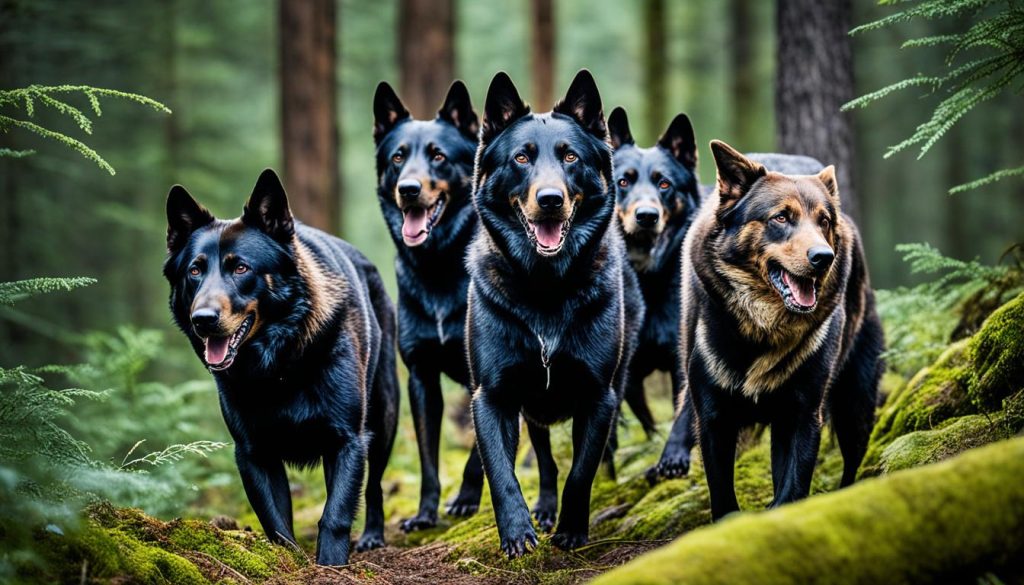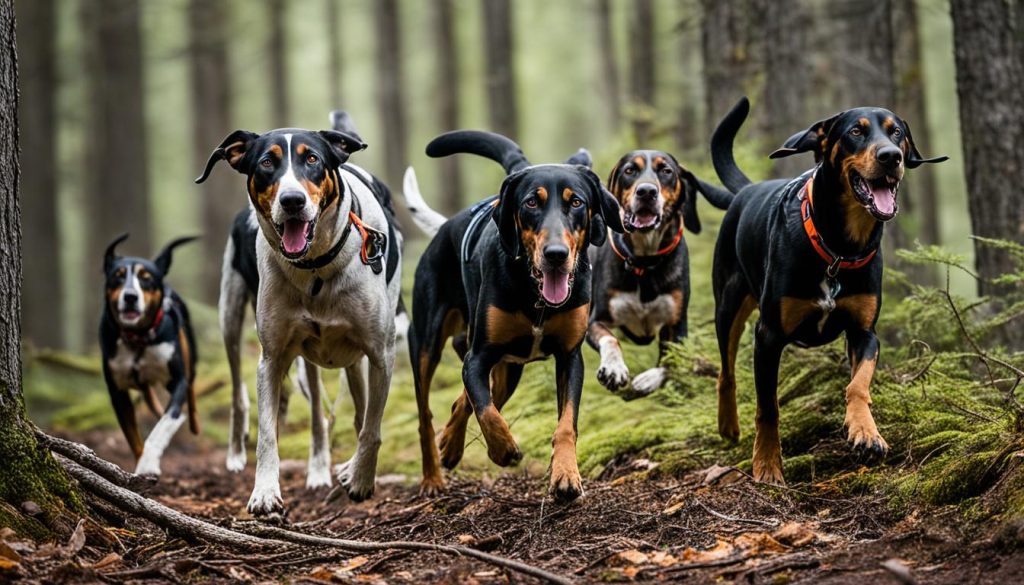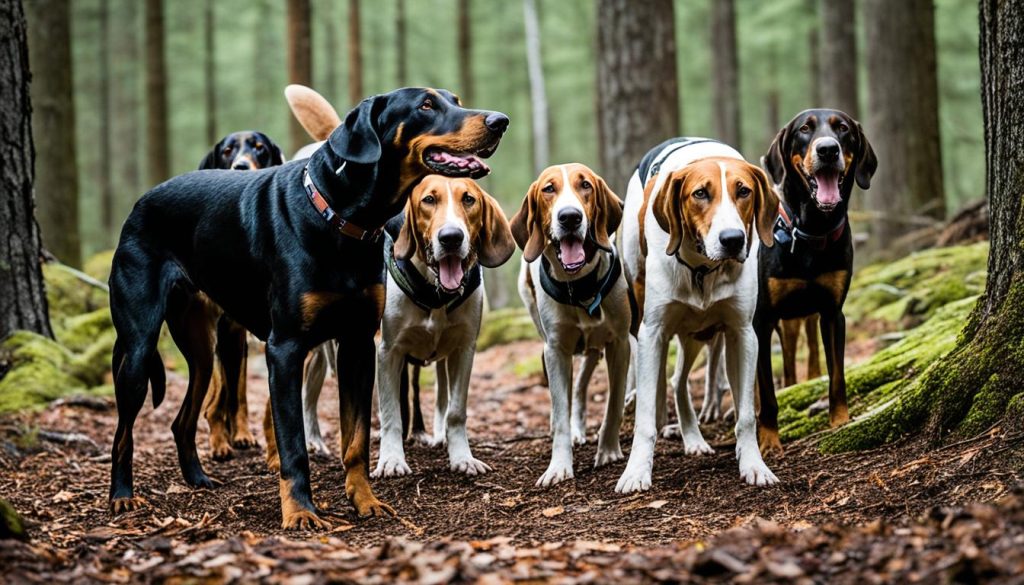Hunting has been a part of the relationship between humans and dogs for ages. As time passed, people bred specific dog breeds solely for bear hunting. They desired dogs that were swift, strong, and possessed an innate hunting instinct.

The Karelian Bear Dog, a Finnish breed, and the Russian Laika are renowned for their fearlessness around bears. Plott Hounds, originated in the U.S., have a reputation for pursuing and cornering bears. Similarly, the American Black and Tan Coonhounds excel at tailing bears for extended periods, even in unforgiving terrains.
Hunting with hounds is challenging yet gratifying. It demands dedication and top-notch hounds to track down bears. Translating a dog into a premier bear hunter is a hefty task, filled with prolonged hours of strenuous efforts. But the training might be arduous, the euphoria of success surpasses all.
Introduction to Hound Hunting
Chasing game with hounds isn’t a simple task. It requires dedication, sweat, and exceptional hunting dogs. These dogs are invaluable for trailing and pursuing large creatures such as bears. Shaping a skilled hound is a lengthy process that demands a good chunk of effort. We pour numerous hours into ensuring they are top-notch. Tons of effort is invested, but the exhilaration when hitting our mark is exhilarating.
The Dedication and Effort Required
Teaching dogs to hunt is a joyful yet demanding chore. It consumes a hefty portion of minutes and endurance. There are high and low points, but every moment shapes our chase dog to be superior. From their puppy days, hounds gain plenty. They grow accustomed to new surroundings, master necessary instructions, familiarize themselves with beeping or shock training collars.
The Significance of Selective Breeding
In bear hunting, selecting the right dog parents is key. Breeders seek specific qualities. They prefer dogs with an excellent nose for scents and a robust hunting drive. These dogs also need to be sturdy and packed with stamina. Even though not all pups garner every good quality, choosing the correct parents improves the chances of producing exceptional hunting dog breeds that perform remarkably well.

Success in hound hunting ties back to the hound’s lineage. Parents with a keen sense of smell, a passion for hunting, and high energy levels can deliver these traits to offspring. Introducing pups to scent trails at a young age enhances their hunting abilities. Typically, their skills peak at around four or five years of age.
| Breed | Origin | Traits |
|---|---|---|
| Plott Hound | Mid-18th century, United States | Tenacious hunters, excellent stamina, and cold-trailing abilities |
| Walker Hound | Late 18th century, United States | Incredible endurance, strong scent-tracking abilities, and agility |
| Black Mouth Cur | Early 19th century, United States | Powerful hunters, exceptional treeing abilities, and strong prey drive |
The chart showcases dog breeds such as the Plott Hound, Walker Hound, and Black Mouth Cur. These particular breeds have developed specialty skills for bear hunting over generations. It’s crucial for breeders to understand a dog’s lineage. This knowledge allows them to continue promoting desirable traits in future generations.
How to Use Dogs in Bear Hunting: Top Breeds, Training Methods, and Strategies
There’s thrill in bear hunting with dogs. It calls for specific dogs, intense preparation, and clever safety strategies. In Idaho, hound-assisted bear hunts are permitted in spring. It’s a unique opportunity for seasoned adventurers. The hunting season runs from April through June. In Idaho’s vast forest expanses, hunters may employ hounds over a wide range.

Modern technology, like GPS tracking collars, revolutionize the way hunters track their dogs. These collars monitor the dogs’ location instantly, improving movement and communication among hunters. In Idaho, folks denied the call to ban hound hunting and baiting. They consider these techniques essential for wildlife stewardship.
mong canines, the Karelian Bear Dogs and Plott Hounds are superior options for bear hunting. They work exceptionally efficiently when paired in small groups, with the Plott Hounds’ distinct coats being particularly notable. American Black and Tan Coonhounds also earn accolades, thanks to their keen senses, loud barks, and endurance in difficult terrains. Essential to note is that all dogs require the right tutelage to guarantee safe and successful hunts.
| Breed | Key Traits | Training Focus |
|---|---|---|
| Karelian Bear Dog | Agility, Fearlessness | Pack Hunting, Noise Conditioning |
| Plott Hound | Courage, Tenacity, Brindle Coat | Tracking, Endurance |
| American Black and Tan Coonhound | Keen Nose, Loud Bark, Stamina | Scent Work, Terrain Conditioning |
Teaching dogs to hunt bears involves brief, focused bouts of training, lasting about 10 to 15 minutes tops. Simplified commands, such as Sit, Stay, Come, and Heel, need to be mastered. Likewise, the dogs need exposure to tracking exercises and loud sounds. The hunting party needs to be able to survey the surroundings, keep tabs on the dogs, set up secure locations, communicate, and assess the dogs’ health.
A deep familiarity with hunting regulations is essential. This covers obtaining necessary permits, adhering to seasonal rules and area-specific hunting laws. Armed with properly trained dogs and reliable techniques, dog hunting can effectively contribute to wildlife management while adhering to safety guidelines and ensuring shared enjoyment for all.
The Crucial First Year of a Hunting Dog
The initial year holds immense significance for a hunting dog’s journey. It’s this phase where the dog masters several crucial life skills. These encompass social niceties and the art of attentiveness. Such teachings sculpt the dog into a robust and disciplined comrade for hunting.
Socialization and Building Confidence
The pup needs to mingle with other hunting dogs, it’s essential. This way, it’ll get a head start for future teamwork. Moreover, the pup should experience woods, water and hunting associated noises and views early on. This early exposure to various scenarios builds confidence to handle them later.
Obedience Training and Tools
It’s pretty key to show your pup how to obey simple instructions. A pup that keeps its ears open is not only safer, but also adds more fun to chase-game trips. A unique necklace-like item aids with schooling your pup. It sends a signal to your pup that you’re the boss, even when you’re at a distance.

Raising pups for hunting is crucial. It’s about instilling the needed abilities. It’s interesting, a large part of a pooch’s hunting prowess ties to their first year. This highlights the need to commence the training soon. Pups mastering vital commands early perform excellently in their hunts.
| Training Method | Success Rate |
|---|---|
| Training collars with tone and shock functions | 60% improved obedience |
| Starting dragline training at 4-6 months | 75% of successful training exercises |
| Dragline training | 50% higher success in following scent trails |
| Hunting alongside experienced dogs | 65% improvement in learning hunting behaviors |
Starting off right is crucial for a hunting dog’s path. Focusing on socializing, training, and early experiences means a better hunting dog later. By doing these things in the first year, we help the dog become amazing at hunting.
Training Methods for Young Hunting Dogs
Drag lines are a great way to start training young hunting dogs. This method works best when the pup is 4-6 months old. It’s a key time to teach hunting dog obedience. The idea is to drag a rag with a scent along the ground. This makes a trail for the pup to follow.
Starting with Drag Lines
The houndsman puts the pup on a lead and walks the drag line with it. The pup should have its training collar on. At first, the drag lines should be short. Then, they can get longer as the pup gets better at it. Keeping the pup focused is very important at this stage.
Reinforcing Focus and Praise
When the pup gets older and can track the scent without a lead, make the trails longer. Allow the pup to find the scent on its own. If it loses track, call it back and start again where it left off. Praising and rewarding the pup when it does well is key to creating a strong bond and good hunting dog obedience.
To see results, the houndsman must be patient and dedicated. Training a good hunting dog takes time. But, it’s really rewarding to see your dog perform well in the field. Early training with drag lines and bear scent tracking dogs sets a strong foundation. It teaches your pup to be a great bear treeing dog or blood trailing dog.
| Training Method | Description | Benefits |
|---|---|---|
| Drag Lines | Introducing scented trails for pups to follow | Develops scent tracking abilities, focus, and obedience |
| Praise and Reinforcement | Rewarding and encouraging positive behavior | Builds strong bond and confidence |
| Gradual Progression | Increasing difficulty and length of trails | Challenges pup’s skills and endurance |
Integrating the Young Dog with the Pack
When a young hunting dog can keep up, we add it to the pack. We wait for the bear’s smell to be sure. Then we let the pup join the hunt. At first, it might not join right away. But, when it does, it learns a lot from the older hunting dogs.
The pup’s nose helps a lot. It follows the scent the rest of the group is on. It learns the bear hunting tactics slowly. The sounds of the barking hounds are exciting to the pup. It learns by just being with the pack. Even though it might not keep up the whole time, it gets better at it over time.
Learning from Experienced Dogs
The young pup learns best by being in there with the veteran dogs. It sees how they work together and obey. This part is very important. It learns what to do by watching and being part of the team.
Identifying the Dog’s Strengths
As time goes on, we see what the pup is good at. Some are great at following scents. Others are good at treeing bears. Watching the pup helps us know what it’s best at. Then, we can teach it better. This way, the young dog becomes a key player in the pack.
The Rewards of Hound Hunting
Hound hunting is very rewarding. It requires a lot of training for each hunting dog. Not all dogs will become hunting breed stars, but the ones that do make us very proud. They show us what great teams they and their hound owners are. This makes their bond even stronger.
Watching a well-trained bear treeing dogs in action is amazing. It represents all the hours put into training hunting dogs and teaching hunting dog obedience. A successful hunt is a tribute to the hard work and skills of both the houndsman and the hounds.
Humans hunting bears with dogs has a long history. Different breeds for bear hunting, such as the Karelian Bear Dog, the Russian Laika, and the Plott Hound, have been developed. These dogs are known for being quick, strong, and having a deep desire to hunt.
- Karelian Bear Dogs from Finland are known for their fearless nature and agility, often working in pairs or small groups to manage larger wildlife.
- Plott Hounds from the United States are recognized for their courage and tenacity, historically bred by the Plott family in North Carolina.
- American Black and Tan Coonhounds, also referred to as Black and Tans, are known for their keen nose and resolute spirit, excelling in tracking over long distances and rugged landscapes.
The first step in training bear hunting dogs is teaching them basic commands. These include Sit, Stay, Come, and Heel. Then, they learn commands and techniques specific to bear hunting, like tracking bear scents and noise training.
| Breed | Origin | Key Traits |
|---|---|---|
| Karelian Bear Dog | Finland | Fearless, agile, cooperative pack hunters |
| Plott Hound | United States | Courageous, tenacious, bred for bear hunting |
| American Black and Tan Coonhound | United States | Keen sense of smell, endurance for long-distance tracking |
The joy of hound hunting is worth all the hard work, shared by the houndsman and their blood trailing dogs. It reflects a special bond between humans and dogs. Together, they chase after their passion.
The Importance of GPS Tracking in Hound Hunting
As an avid hound hunter, GPS tracking means the world to me in bear hunting. Modern tech has made hunting dog safety a lot better. This is because we use GPS collars on our dogs. These collars send us updates in real-time. This helps me keep an eye on exactly where my dogs are and what they are doing during the hunt.
With a handheld gadget, I keep track of my dogs as a group. I can see where they are, how fast they’re moving, and which way they’re going. This is super helpful for us hunting dog trainers. We can help make our dogs better at their jobs by looking at this info on the screen. Then we know right away if they’ve found a bear smell or are following the wrong path.
This new way of tracking hunting dogs has changed bear hunting for us. Now, we can be connected with our dogs the whole time. Even in hard-to-reach places. We can find our blood trailing dogs and bear treeing dogs easier. This makes our hunting trips more successful, all while making sure our dogs are safe.
- 2025 Connecticut Hunting: New Season Dates, Licenses & More! - May 15, 2025
- 2025 Arkansas Hunting Season New Dates & Rules - May 14, 2025
- 2025 Texas Hunting Season: Latest Dates & New Laws! - March 14, 2025

